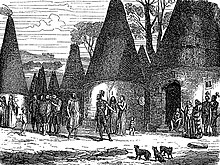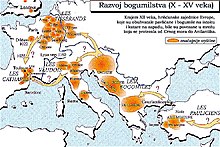| Part of a series on |
| Slavery |
|---|
 |



The Balkan slave trade was the trade in slaves from the Balkans via Venetian slave traders across the Adriatic and Aegean Seas to Italy, Spain and the Islamic Middle East, from the 7th-century Early Middle Ages until the mid-15th century. It was one of the routes of the Venetian slave trade.
The trade rested on the fact that the Balkans was a religious border zone, which was significant in the middle ages, when religion was the determining factor on who was viewed as a legitimate target of enslavement. The Balkans was Pagan territory long in to the middle ages. After it had converted to Christianity by the 11th-century, it was Orthodox Christianity and Bogomilism, which maintained its status as a religious border zone to the rest of then Catholic Europe. The slave trade of first Pagan and then Orthodox and Bogomile Christian Slavs were exported to Italy, Spain and Portugal in Southern Europe, but the major part of the export went to the Muslim Middle East.
The Balkan slave trade was one of the main routes of European Saqaliba-slaves to the Islamic Middle East, alongside the Prague slave trade in the West, and the Black Sea slave trade, the Khazar slave trade and the Bukhara slave trade in the East. It was a major contributor of mamluk slave soldiers to the Mamluk Sultanate of Egypt. The Balkan slave trade contributed to the establishment of the Republic of Venice as a prosperous trading empire in the Mediterranean Sea in the early middle ages.
In the 15th-century, the Balkan slave trade was closed of from Europe due to the Muslim Ottoman conquest of the Balkans, and consequently integrated to the Ottoman slave trade. The end of the Balkan slave trade's supply of slaves to Spain and Portugal contributed to the establishment of the Atlantic slave trade, when there was a demand of slaves to the new Spanish colonies of the New World, and the old Balkans slave supply source had to be replaced by a new source of non-Catholic slaves.
© MMXXIII Rich X Search. We shall prevail. All rights reserved. Rich X Search
